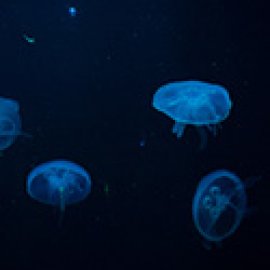Marine Biomimetics, part two
-
English
-
ListenPause
Intro music
Welcome to World Ocean Radio
I’m Peter Neill, Director of the World Ocean Observatory.
We are discussing today a new perspective and approach to scientific inquiry and understanding in the ocean. Called “biomimetics,” it is design inspired by marine life and its application to systems and solutions as we face choices and actions required to adapt successfully to present and future conditions. We have discussed biomimicry before as it has developed and pertained to terrestrial phenomenon; biomimetics is biomimicry in action, in our context of conditions revealed in the ocean and marine species that are specific and applicable. This discussion is informed by an article in PNAS, an academic journal published by Oxford University Press for the National Academy of Science and the Stockholm Resilience Center in Sweden, entitled “A Forgotten Element in the Blue Economy: Marine Biomimetics and Inspiration from the Deep Sea,” authored by Robert Blasiak and colleagues.
Here are some definitions that will help to understand this fascinating new way of thinking and engaging with Nature. Biomimicry is “learning from and emulating Nature’s forms, processes, and ecosystems to create more sustainable designs.” Think bullet trains. Biomimetics is “the process of mimicking the formation, structure or function of a biologically produced substance or materials to create or synthesize an artificial product.” Think Velcro. Biomechanics is the study of mechanical physics of biological processes. Think aerodynamics. Bio-utilization is the direct use of Nature for ecological benefit. Think medicinal plants. Bio-remediation is the use of micro-organisms or enzymes to detoxify contaminates. Think oil spill clean-up. Bio-affiliation is the idea that human feel better and are healthier in contact and connected to Nature. Think parks and recreation.
What captured my attention most was the identification of several broad groupings of biomimetic applications specific to the ocean, to include adhesion, anti-fouling, armor, buoyancy, movement, sensory capacity, stealth, schooling, electro-chemical connection, fluorescence, and novel constructs. And even more compelling are the special conditions of the ocean: oxygenation, acidity, salinity, metals concentration, pressure, temperature, light – all extremes wherein marine species survive and thrive uniquely independent of terrestrial conditions, inspirational in that the “knowledge” contained therein remains to be discovered and applied.
Let me give some examples from the many cited in the PNAS article: the
Atlantic Hagfish, all head, no spine, that emits instantaneously a defense slime of thousands of silk-like threads, resulting in over 1100 patents for adaptation to high performance fibers, safety helmets, and bullet-proof vests; the deep sea sponge with its unique porosity and internal structure that has been applied to bone substitution, tissue engineering applications, modern architectural design and construction, fiber optics, and bioremediation; the Ram’s Horn squid, with its internal expanding gas-filled spiral-formed swim bladder that adapts to sudden change in pressure that has informed design of manned submersibles such as DeepSea Challenger which in 2012 descended to the ocean’s deepest point; or the Scaly-foot snail, recently discovered in hydro-thermal vents with its protective multi-layered iron-mineralized shell that has informed research in armor development, or the bacterium S. alvidoflavus, found throughout the Pacific Ocean with novel compounds that have been adapted to non-toxic anti-fouling treatment of ships and other marine structures.These represent big solutions from small things, often invisible, many newly discovered, that when mimicked or synthesized lead to applications that mitigate or prevent problems, in effect, examples of the self-healing capacity of natural phenomena that protects and provides. At academic conferences and scientific meetings, there is a constant call for more research, more research to advance solution to the many negatives problems we have created or to the invention of alternative methods and products that better our lives. Research is defined as “the systematic investigation into and study of materials and sources in order to establish facts and reach new conclusions.” The ocean is a vast laboratory for such investigation; we despoil it at the peril of losing those facts, those conclusions, what we have and what will help and heal and meet our need to survive.
We will discuss these issues, and more, in future editions of World Ocean Radio.
outro music
In these three episodes of World Ocean Radio we are exploring a recent publication entitled “A Forgotten Element in the Blue Economy: Marine Biomimetics and Inspiration from the Deep Sea,” authored by Robert Blasiak from the Stockholm Resilience Center in Sweden. The article identifies seven broad categories of biomimetic design: adhesion, anti-fouling, armor, buoyancy, movement, sensory, and stealth. In this 3-part series we'll discuss each with examples of application, technological invention, and as effective solution models for response to negative human intervention and climate change, and for ocean protection and conservation.
About World Ocean Radio
World Ocean Radio provides coverage of a broad spectrum of ocean issues from science and education to advocacy and exemplary projects. Hosted by Peter Neill, Director of W2O, World Ocean Radio is a weekly series of five-minute audio essays available for syndicated use at no cost by college and community radio stations worldwide.
- Login to post comments



